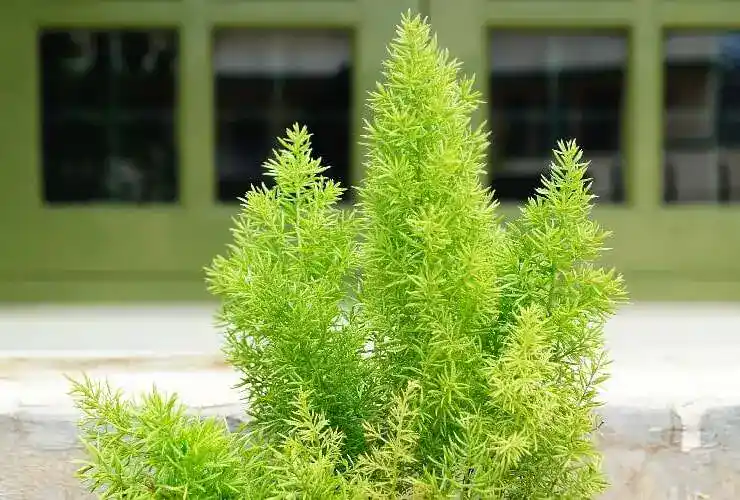Are you struggling to keep your outdoor asparagus fern alive and thriving? Look no further! This article will provide expert tips and tricks for successful outdoor asparagus fern care.
Asparagus ferns are a beloved addition to many gardens and outdoor spaces, but they can be challenging to care for. Fortunately, with the right knowledge and techniques, anyone can grow a healthy and beautiful outdoor asparagus fern.
Key Takeaways:
- Understanding the basics of outdoor asparagus fern care is essential for ensuring a healthy and thriving plant.
- Creating the best growing conditions, including sunlight, temperature, and soil requirements, is crucial for outdoor asparagus ferns to thrive.
- Proper pest control, winter care, fertilization, and propagation techniques can help keep your outdoor asparagus fern happy and healthy.
- If problems arise, troubleshoot common issues to ensure a healthy and thriving plant.
Understanding the Basics of Outdoor Asparagus Fern Care
Outdoor asparagus ferns are relatively low-maintenance plants, but they still require proper care to thrive. To ensure your outdoor asparagus ferns stay healthy, it’s important to understand the basics of their care requirements. Below are some essential tips for watering and pruning your outdoor asparagus ferns to keep them looking their best.
Outdoor Asparagus Fern Watering
One of the most critical aspects of outdoor asparagus fern care is proper watering. These plants love humid conditions, so don’t let the soil dry out completely between watering. It’s best to keep the soil slightly moist at all times, so aim to water your ferns once or twice a week, depending on the weather. If your area experiences hotter temperatures, you may need to water your plant more frequently.
When watering your outdoor asparagus fern, make sure to give it a deep, thorough soaking rather than just a light sprinkling. This allows the roots to absorb as much water as possible. You can also mist the foliage regularly to keep the humidity levels high, which will help prevent the leaves from drying out.
Outdoor Asparagus Fern Pruning
Pruning is another essential aspect of outdoor asparagus fern care. Regular pruning helps keep the plant looking neat and tidy and also encourages healthy growth. You should prune your ferns once or twice a year, ideally in the spring or early fall. Remove any dead or yellowing leaves and cut back overgrown stems to encourage new growth.
When pruning your outdoor asparagus ferns, be sure to wear gloves, as the plant’s thorns can be quite sharp. Use a clean, sharp pair of pruning shears and cut the stems at a slight angle, just above a node or a set of leaves. This will help the plant heal quickly and prevent any damage to the remaining foliage.
Creating the Best Growing Conditions for Outdoor Asparagus Ferns
Outdoor asparagus ferns thrive in specific conditions, so it’s essential to create the ideal environment for your plant to grow and flourish.
| Condition | Ideal Range |
|---|---|
| Sunlight | Partial shade to bright, indirect light |
| Temperature | 60-75°F (15-24°C) |
| Soil | Well-draining, acidic soil with a pH of 5.5-6.5 |
In terms of sunlight, it’s best to place your outdoor asparagus fern in an area with partial shade to bright, indirect light. Direct sunlight can scorch the fronds and cause damage to the plant.
Temperature is another important factor to consider. Outdoor asparagus ferns prefer temperatures between 60-75°F (15-24°C). Avoid exposing your plant to extreme or fluctuating temperatures, as this can cause stress and harm to the plant.
The soil you choose for your outdoor asparagus fern is critical. It should be well-draining and have a pH of 5.5-6.5, which is slightly acidic. Avoid using heavy or compacted soil, as this can lead to root rot or other issues.
By providing the optimal growing conditions for your outdoor asparagus fern, you can ensure that it remains healthy and vibrant for years to come.

Pest Control for Outdoor Asparagus Ferns
Outdoor asparagus ferns are vulnerable to pest infestations, which can cause damage to the plant and affect its overall health. Common pests that affect outdoor asparagus ferns include spider mites, scales, and mealybugs. Here are some tips to prevent and treat pest problems:
Prevention
The best way to deal with pest problems is to prevent them from occurring in the first place. Here are some tips:
- Inspect new plants before bringing them home to ensure that they are pest-free.
- Keep the area around the plant clean and free of debris, which can harbor pests.
- Avoid overwatering or underwatering the plant, as this can weaken it and make it more susceptible to pests.
- Make sure the plant is getting the right amount of sunlight and is not being stressed by extreme temperatures or other environmental factors.
Treatment
If you notice signs of a pest infestation on your outdoor asparagus fern, here are some steps you can take to treat the problem:
- Remove any heavily infested leaves or branches from the plant.
- Wash the remaining foliage with a mild soap and water solution to remove any remaining pests.
- Treat the plant with an insecticide specifically designed for outdoor asparagus ferns. Be sure to follow the instructions carefully and avoid overuse of the product.
- Monitor the plant closely for any signs of recurring pest problems and take steps to prevent future infestations.
Note: If you are unsure about the type of pest affecting your outdoor asparagus fern or are having trouble controlling an infestation, consider consulting with a professional pest control service.
Winter Care for Outdoor Asparagus Ferns
During the winter months, outdoor asparagus ferns may need extra attention to survive the cold temperatures. Here are some expert tips for keeping your plants healthy and thriving:
Protect from frost
When temperatures drop below freezing, outdoor asparagus ferns are at risk of frost damage. To protect your plants, cover them with frost cloth or blankets overnight. Alternatively, move potted ferns indoors to a warmer area.
Reduce watering
During the winter, outdoor asparagus ferns enter a dormant phase and require less water. Be sure to let the soil dry out partially before watering, as overwatering can cause root rot and other issues.
Provide ample sunlight
Although asparagus ferns can tolerate some shade, they still require plenty of sunlight to photosynthesize and produce energy. If possible, move your plants to a spot where they receive several hours of direct sunlight each day.
Prune away dead foliage
During the winter, asparagus ferns may shed some of their leaves as part of their natural growth cycle. To keep your plant looking tidy, remove any dead or yellowed foliage as needed.
- Expert Tip: If your outdoor asparagus ferns experience frost damage, wait until spring to prune away any dead foliage. The plant may still be able to recover and produce new growth once temperatures warm up.
Fertilizing Outdoor Asparagus Ferns
Proper fertilization is essential to the health and growth of outdoor asparagus ferns. These plants require regular feeding during the growing season to support their lush foliage and delicate fronds.
The best time to fertilize outdoor asparagus ferns is in the spring, just as new growth begins to emerge. Use a balanced, water-soluble fertilizer, such as a 10-10-10 or 20-20-20 blend, and follow the manufacturer’s instructions for application rates.
It’s important not to over-fertilize outdoor asparagus ferns, as this can cause damage to the roots and lead to stunted growth. Avoid applying fertilizer during periods of drought or extreme heat, as this can also harm the plant.
During the summer months, you can continue to fertilize your outdoor asparagus ferns every four to six weeks. Keep in mind that these plants are heavy feeders, so be sure to provide them with enough nutrients to support healthy growth.
If you notice that your outdoor asparagus ferns are not responding to fertilizer, or if they appear yellowed or stunted, it may be a sign of nutrient deficiencies. In this case, you can apply a specialized fertilizer that is high in nitrogen and iron to help boost growth and improve overall health.
Propagating Outdoor Asparagus Ferns
Propagating outdoor asparagus ferns is a great way to expand your plant collection, and it’s relatively easy to do. There are two primary methods for propagating outdoor asparagus ferns: division and spore propagation.
Division Propagation
Division propagation involves separating the fern’s roots and replanting them in a new container or area of your garden. Follow these simple steps to propagate your outdoor asparagus fern through division:
- Carefully remove the plant from its container or garden bed.
- Separate the fern’s roots into smaller sections, ensuring each section has its own set of leaves.
- Plant each section in a new container or garden bed with fresh soil.
- Water the newly planted sections thoroughly and keep them moist until they establish themselves in their new location.
Spore Propagation
Spore propagation involves collecting spores from your outdoor asparagus fern and planting them in a suitable growing medium. Follow these steps to propagate your outdoor asparagus fern through spore propagation:
- Look for small, brownish bumps on the backs of your fern’s leaves. These are spore clusters.
- Cut the spore clusters from the leaves and place them in a paper envelope.
- Label the envelope with the date and the plant’s name, and store it in a dry, cool place until the spores mature (typically 1-2 weeks).
- When the spores are mature, sprinkle them over a container of moist potting soil.
- Cover the container with plastic to create a greenhouse-like environment and keep it in a warm, bright location (but out of direct sunlight).
- Keep the soil moist and wait for the spores to germinate and grow into young ferns.
- Once the young ferns have established themselves, you can transplant them into containers or your garden.
Propagation is a great way to share your love of gardening with friends and family while also expanding your own plant collection. With just a little bit of patience and effort, you can successfully propagate your outdoor asparagus fern and enjoy the beautiful foliage it provides.
Troubleshooting Common Issues in Outdoor Asparagus Fern Care
Despite providing the best care for your outdoor asparagus ferns, problems can still arise. Here are some common issues and their solutions:
Yellowing or Browning Leaves
If the leaves of your fern are turning yellow or brown, it may be a sign of over or underwatering. Check the soil moisture and adjust watering accordingly. Make sure the pot has proper drainage and that water is not sitting at the bottom of the pot.
Wilting or Drooping Leaves
Wilting or drooping leaves may indicate underwatering. Additionally, if the soil is too dry, it may not be able to absorb water properly. Check the soil moisture and water the fern if necessary.
Discolored or Spotted Leaves
Discolored or spotted leaves may be a sign of pest infestation. Check the leaves and stems for signs of insects or mites and treat accordingly.
Stunted Growth or No Growth
If your fern is not growing or is growing slowly, it may need more sunlight or fertilization. Move the plant to a sunnier spot or fertilize with a balanced fertilizer every two weeks during the growing season.
Yellowing Fronds
If the fronds of your fern are turning yellow, it may be a sign of old age. Trim the fronds to promote new growth.
By addressing these common issues, you can ensure that your outdoor asparagus ferns remain healthy and thriving.


